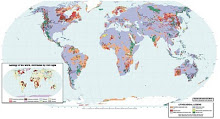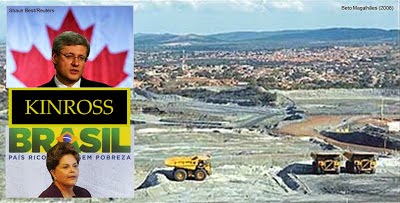Letter to Professor Alastair Summerlee, President and Vice-Chancellor of the University of Guelph, Ontario, Canada
November 21, 2010
To
Professor Alastair Summerlee
President and Vice-Chancellor of the University of Guelph
president@uoguelph.ca
Mr. President,
Having read the announcement that the University of Guelph accepted a $1-million gift from Kinross Gold Corporation [1], I feel obliged to inform you that this gift has been made possible thanks to questionable Kinross’ mining activities, especially at my home town Paracatu, state of Minas Gerais, Brazil.
Your declaration that ‘Kinross has an excellent reputation for leadership in resource management and for its commitment to social responsibility’ is appalling. There is simply no such thing as ‘Kinross’ commitment to social responsibility’, unless we are talking about ‘green washing’ and ‘social washing’.
To get its gold from Brazil’s largest opencast-, world’s lowest grade- (average 0.4 g of gold/ton of ore), largest arsenic grade- (average 2000 g of arsenic/g of gold) gold mine at Paracatu, Kinross Gold operates massive environmental damages, displacement of local people from their homes, chronic poisoning as well as murder.
Kinross claims that it operates under strict legal terms in Brazil. Truth is, Kinross has been sued in several Civil Actions proposed by the Brazilian State and Federal Public Ministries and the Acangau Foundation, among others. Kinross’ robbing and polluting drinking water, polluting soils and the atmosphere with millions of tons of arsenic, cyanide and sulphuric acid among other pollutants, expelling native people from their constitutionally and legally protected territories, hiding or manipulating information and killing people are simply against the Brazilian Constitution and against national and international law. It is also immoral, inhumane and bad for mankind.
The environmental and health liabilities left behind by Kinross Gold Corporation in Paracatu are estimated in the tens of billions, thus 5- to 10-fold the value of all the gold reserves exploited and to be exploited by Kinross in Paracatu. Whereas some of these liabilities are left for Brazilian taxpayers to pay, some are left for mankind to pay.
There is vast scientific evidence that arsenic released by hard rock mining is mobilized in many environmental compartments in the course of years, centuries and millennia. Chronic exposure to environmental arsenic has been implicated as a cause or predisposing factor for each of the top ten causes of death in the world, including vascular diseases, various forms of cancer, diabetes and immunological diseases (see www.sosarsenic.blogspot.com for reviews).
I have recently authored a study in the journal Medical Hypotheses in which I review the hazards of arsenic release from gold mines worldwide, including Kinross' Paracatu gold mine [2]. This study has won immediate coverage in the media [3,4]. In the study, I have estimated that thousands of gold mines worldwide have the potential to release 10-100 kg of arsenic per each human being presently living on planet Earth.
Whereas 100 milligrams of arsenic suffice to acutely kill an adult man, much lesser amounts – in the part per billion range – are enough to chronically kill or cause serious health and economical distresses to billions of people, eroding family and country economies worldwide. This means that less than 0.0001% of all arsenic released by gold mining is enough to cause extraordinary health and environmental damage to mankind. This also means that gold mining corporations like Kinross Gold had to operate at 99.9999% arsenic recovery and immobilization efficiency in order to prevent damage. This degree of efficiency is clearly unattainable, rendering hard rock gold mining a genocidal activity.
Particularly in the case of Paracatu, a study performed by Kinross in collaboration with CETEM indicates an efficiency of only 30% [5], and recent studies performed independently by renowned Brazilian and German institutions implicate Kinross’ mining activities in Paracatu as the cause of active and persistent pollution of air, soils, waters and sediments with arsenic reaching concentrations that are up to 750-fold increased in relation to nationally and internationally accepted safety levels.
Unfortunately, environmental remediation of arsenic is economically unfeasible for affected communities and countries, as has been recently shown by a Swedish team [6].
Therefore, Kinross mining operations in Paracatu and elsewhere are worse than crimes, they are errors that must be avoided because they are difficult if not impossible to remediate, and too bad for all of us.
We trust that you will prioritize the points that I made in this letter, in assessing Kinross’ gold mining activities in Paracatu.
Please do not hesitate to contact me in case of any doubt or in case I can be of any help.
Sincerely,
Sergio U. Dani, MD, DSc
The Medawar Institute for Medical and Environmental
Research/Acangau Foundation, Paracatu, Brazil
References and notes:
[1] Kinross Gold, U of G Announce Chair in Environmental Governance. November 17, 2010 - News Release. From http://www.uoguelph.ca/news/2010/11/kinross_gold_u.html [accessed November 18, 2010].
[2] Dani SU. Gold, coal and oil. Medical Hypotheses doi:10.1016/j.mehy.2009.09.047
[3] http://news.discovery.com/human/human-extinction-doomsday.html
[4] http://www.theglobeandmail.com/life/facts-and-arguments/arsenic-and-our-fate-appearances-count-and-middle-class-theft/article1361341/?utm_source=feedburner&utm_medium=feed&utm_campaign=Feed%3A+TheGlobeAndMail-Front+(The+Globe+and+Mail+-+Latest+News
[5] Monte MBM, Lins FF, Dutra AJB, Albuquerque CRF, Tondo LA. The influence of the oxidation state of pyrite and arsenopyrite on the flotation of an auriferous sulphide ore. CT2002-195-00 Comunicação técnica elaborada para o periódico Minerals Engineering. CETEM-Centro de Tecnologia Mineral, MCT-Ministério da Ciência e Tecnologia, Coordenação de Inovação Técnológica - CTEC, Rio de Janeiro, Dezembro/2002.
[6] Forslund J, Samakovlis E, Johansson MV, Barregard L. Does remediation save lives? - on the cost of cleaning up arsenic-contaminated sites in Sweden. Sci Total Environ. 2010 Jul 15;408(16):3085-91.
Sunday, November 21, 2010
Subscribe to:
Post Comments (Atom)




No comments:
Post a Comment